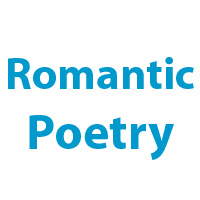What is Romantic Poetry?
It is generally supposed that the English Romantic Movement began in 1798 with the publication of the "Lyrical Ballads" but it is not a sudden outburst but the result of long and gradual growth and development. The term 'Romanticism' (the Romantic Movement) is a literary movement which took place in Britain and throughout Europe roughly between 1770 and 1848. Politically, it was inspired by the revolutions in America and France.

Emotionally, it expressed an extreme assertion of the self and the value of the individual experience together with the sense of the infinite and the transcendental. The stylistic keyword of ‘Romanticism’ is intensity and its watchword is ‘Imagination’. In Britain, Romantic writers of the first generation included Wordsworth and Coleridge (Lyrical Ballads, 1798), Blake and Burns, though introspective 18th century poets such as Gray and Cowper show pre-Romantic tendencies. The second generation of British Romantics- Byron, Shelley and Keats absorbed these tumultuous influences, wrote swiftly, travelled widely and died prematurely. Their life stories and letters became almost as important for Romanticism as their poetry.
Romanticism does not mean any one thing or one characteristic. It is, in fact, a collective term to mean certain features and characteristics, such as mysticism, humanism, supernaturalism, escapism, love of beauty, love of nature, love of equality, alienation, fanciful, melancholy, wonder, emotional intensity, rich imagination, subjectivism, simple diction, sensuousness, love for medievalism, etc. It wanted to free literature from tyranny of the rules of the ancients. English romanticism is both a revolt and a revival. It is a revolt against 18th century traditions and conventions; it is a revival of medievalism and old English meters and masters of poetry. The chief characteristics of romantic poetry are as follows:
Subjectivity: All romantic literature is subjective. It is an expression of the inner urges of the soul of the artist. The poet gives free expression to his feelings, emotions, experiences, thoughts and ideas and does not care for rules and regulations. The emphasis is laid on inspiration and intuition.
Love of Nature: Zest for the beauties of the external world characterizes all romantic poetry. Romantic poetry carries us away from the suffocating atmosphere of cities into the fresh and invigorating company of the out of door world. All poets were lovers of nature and looked at the beautiful aspects of nature. To them, nature was a friend, a lover, a mother, sister and a teacher. To Wordsworth, nature was both mother and sister. He spiritualizes nature, Shelley intellectualizes nature and Keats is content to observe nature through his senses.
Spontaneity: Romantic poetry is the spontaneous overflow of powerful feelings. Poetry to romantic poets is not a craft but inspiration. The poet does not care for the perfection of form or clarity of expression.
Melancholy: Most of the romantic poets in English are full of melancholy and pessimism. A romantic is dissatisfied individual. He may be dissatisfied with the circumstances of his own, with his age, with literary conventions and traditions of the day, or with the general fate of humanity.
Supernaturalism and Mysticism: Romanticism was a revival of medievalism. The romantic is extraordinarily alive to the wonder, mystery and beauty of the universe. The unseen world is more real for him than the world of the senses. Romantic poetry is mystical and is removed from the everyday experiences of life.
A Revolt: Romantic Movement in literature is a revolt. It was a revolt against the 18th century poetic style of artificiality.
Imagination and Emotion: The romantic poets laid emphasis on imagination and emotion. The 18th century neo-classical poets had emphasized on reason and intellect.
For example, we can take Wordsworth’s romantic poem “I Wandered Lonely as a Cloud” which deals with subjects of creative imagination, childhood memories, beauty of nature, the role of nature as a guiding spirit .The poem “I Wanderd Lonely as a Cloud” is not only a typical romantic poem, but it also tells us how a poem is written in the romantic sense. This poem is romantic is in its subject and theme, and in its expression and word game. The subject is that of the poet’s personal experience in nature. The expression is emotive and imaginative. The nature is personified. The poet felt that the daffodils were dancing better than the sea waves. They were happy like the children. Now, as the poet is sitting at home, the daffodils revisit him in his mind’s eye, and he writes the poem. The poem is, therefore, not only romantic, but also satisfies Wordsworth’s idea of what poetry is and how it is written. This is typically as a poem based on the poet’s emotions recollected in tranquillity.
Published on 24 Jan. 2014 by Kedar Nath Sharma
